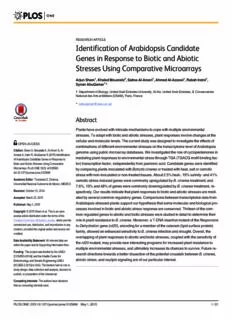
Identification of Arabidopsis Candidate Genes in Response to Biotic and Abiotic Stresses Using ... PDF
Preview Identification of Arabidopsis Candidate Genes in Response to Biotic and Abiotic Stresses Using ...
RESEARCHARTICLE Identification of Arabidopsis Candidate Genes in Response to Biotic and Abiotic Stresses Using Comparative Microarrays ArjunSham1,KhaledMoustafa2,SalmaAl-Ameri1,AhmedAl-Azzawi1,RabahIratni1, SynanAbuQamar1* 1 DepartmentofBiology,UnitedArabEmiratesUniversity,Al-Ain,UnitedArabEmirates,2 Conservatoire NationaldesArtsetMétiers(CNAM),Paris,France * [email protected] Abstract Plantshaveevolvedwithintricatemechanismstocopewithmultipleenvironmental stresses.Toadaptwithbioticandabioticstresses,plantresponsesinvolvechangesatthe cellularandmolecularlevels.Thecurrentstudywasdesignedtoinvestigatetheeffectsof OPENACCESS combinationsofdifferentenvironmentalstressesonthetranscriptomelevelofArabidopsis Citation:ShamA,MoustafaK,Al-AmeriS,Al- genomeusingpublicmicroarraydatabases.Weinvestigatedtheroleofcyclopentenonesin AzzawiA,IratniR,AbuQamarS(2015)Identification mediatingplantresponsestoenvironmentalstressthroughTGA(TGACGmotif-bindingfac- ofArabidopsisCandidateGenesinResponseto BioticandAbioticStressesUsingComparative tor)transcriptionfactor,independentlyfromjasmonicacid.Candidategeneswereidentified Microarrays.PLoSONE10(5):e0125666. bycomparingplantsinoculatedwithBotrytiscinereaortreatedwithheat,saltorosmotic doi:10.1371/journal.pone.0125666 stresswithnon-inoculatedornon-treatedtissues.About2.5%heat-,19%salinity-and41% AcademicEditor:TzvetankaD.Dinkova, osmoticstress-inducedgeneswerecommonlyupregulatedbyB.cinerea-treatment;and UniversidadNacionalAutonomadeMexico,MEXICO 7.6%,19%and48%ofgeneswerecommonlydownregulatedbyB.cinerea-treatment,re- Received:October31,2014 spectively.Ourresultsindicatethatplantresponsestobioticandabioticstressesaremedi- Accepted:March23,2015 atedbyseveralcommonregulatorygenes.Comparisonsbetweentranscriptomedatafrom Arabidopsisstressed-plantssupportourhypothesisthatsomemolecularandbiologicalpro- Published:May1,2015 cessesinvolvedinbioticandabioticstressresponseareconserved.Thirteenofthecom- Copyright:©2015Shametal.Thisisanopen monregulatedgenestoabioticandbioticstresseswerestudiedindetailtodeterminetheir accessarticledistributedunderthetermsofthe CreativeCommonsAttributionLicense,whichpermits roleinplantresistancetoB.cinerea.Moreover,aT-DNAinsertionmutantoftheResponsive unrestricteduse,distribution,andreproductioninany toDehydrationgene(rd20),encodingforamemberofthecaleosin(lipidsurfaceprotein) medium,providedtheoriginalauthorandsourceare family,showedanenhancedsensitivitytoB.cinereainfectionanddrought.Overall,the credited. overlappingofplantresponsestoabioticandbioticstresses,coupledwiththesensitivityof DataAvailabilityStatement:Allrelevantdataare therd20mutant,mayprovidenewinterestingprogramsforincreasedplantresistanceto withinthepaperanditsSupportingInformationfiles. multipleenvironmentalstresses,andultimatelyincreasesitschancestosurvive.Futurere- Funding:ThisprojectwasfundedbytheUAEU searchdirectionstowardsabetterdissectionofthepotentialcrosstalkbetweenB.cinerea, [COS/IRG-05/14];andtheKhalifaCenterfor BiotechnologyandGeneticEngineering-UAEU abioticstress,andoxylipinsignalingareofourparticularinterest. [KCGEB-2-2013]toSAQ.Thefundershadnorolein studydesign,datacollectionandanalysis,decisionto publish,orpreparationofthemanuscript. CompetingInterests:Theauthorshavedeclared thatnocompetinginterestsexist. PLOSONE|DOI:10.1371/journal.pone.0125666 May1,2015 1/21 MicroarrayAnalysisofArabidopsis-StressedPlants Introduction Plantsareimmobileorganismsconvictedtofacenumerousenvironmentalstressesduring theirlifetime.Bioticandabioticstressesoftenoccursuddenlyand/orsimultaneously;and,im- mediateplantresponsesarethereforecriticaltoensurecellsurvival[1].Afundamentalstrategy forplantstoadapttoenvironmentalchallengesimposedbybioticandabioticthreatsisthe modulationofgeneexpression.Atthecellularlevel,plantstunegeneexpressionalongwith theirphysiologicalneedstopromoteadaptationtoshort-aswellaslong-termenvironmental changes.Now,thereisgrowingevidencethatplantsreprogramtheirresponsesundercontinu- ouslychangingenvironmentalfactorsindividually,ormorefrequently,incombination.De- pendingontheenvironmentalconditionsencountered,plantsactivateaspecificprogramof geneexpression[2].Thespecificityofresponseisfurthercontrolledbyarangeofmolecular mechanismsthat“crosstalk”inacomplexregulatorynetwork,includingtranscriptionfactors, kinasecascades,reactiveoxygenspecies,heatshockfactorsandsmallRNAsthatmayinteract witheachother[3].Theinteractionbetweenbioticandabioticstressesisorchestratedbyhor- moneandnon-hormonesignalingpathwaysthatmayregulateoneanotherpositivelyornega- tively.Inresponsetobioticorabioticstress,geneexpressionstudiesfoundthatdisease resistance-relatedgenesincorncouldbeinducedorrepressedbyabioticstresses[4]. SeveralstudieshaveidentifiedtheregulationofsinglegenesinresponsetoB.cinereaand abioticstress.ArabidopsisBotrytisSusceptible1(BOS1),Botrytis-inducedKinase1(BIK1), WRKY33geneswerepreviouslyidentified[5–7].Incomparisonwithwild-typeplants,the threemutantsbos1,bik1andwrky33wereextremelysusceptibletoB.cinerea.TheMYBtran- scriptionfactor,BOS1,playsamajorroleinplantdefenseresponsetoB.cinereathatisregulat- edbyjamonate(JA)[5].Thesusceptibilityofbos1mutanttoB.cinereawasalsolinkedto alteredplantsensitivitytooxidativestress.BIK1gene,inturn,encodesamembrane-associated kinaseproteininwhichbik1mutantshowedhighsalicylate(SA)levelsbeforeandaccumulated afterB.cinereainoculation[6].WhileWRKY33transcriptionfactorshowedacrosstalkbe- tweenJA-andSA-regulateddiseaseresponsepathways,bothBIK1andWRKY33playanan- tagonisticroleinplantdefenseaspositiveandnegativeregulatorstoresistancetoB.cinerea andPseudomonassyringaepvtomato,respectively[5,6].Effortstowardstheidentificationof ArabidopsisBOS1interactors(BOI)andBIK1regulatorshaveledtouncoverthefunctionof someinteractorsandregulatorsinplantresponsestopathogeninfectionandabioticstress[8, 9].Recently,theArabidopsismutationexpansin-likeA2(EXLA2)enhancedresistanceto necrotrophicfungi,butcausedhypersensitivitytosaltandcoldstresses[10].UponB.cinerea attack,anaccumulationofcyclopentenonesresultedintherepressionofEXLA2;whereas EXLA2inductionwasdependentonabscisicacid(ABA)responses[10,11]. Theimpactofanabioticstresscanalsoleadtoincreasedresistanceorsusceptibilitytoa pathogen,orviceversa.Theplant-parasiticnematodeMeloidogynegraminicolareducedthe damageofdroughtonrice(Oryzasativa)growth[3].Bycontrast,drought-stressedsorghum (Sorghumbicolor)andcommonbean(Phaseolusvulgaris)showedincreasedsusceptibilityto thesamefungusMacrophominaphaseolina[12,13].InArabidopsis,drought-stressedplants showedseveresusceptibilitytothebacterialpathogenP.syringae[14].Ontheotherhand,in tomato(Solanumlycopersicum)andbarley(Hordeumvulgare),itwasfoundthatincreasingthe toleranceleveltodrought,saltandosmoticstressalsoenhancedtheresistancetoBlumeriagra- minisandB.cinerea[15,16].Thesefindingssuggestthatbioticandabioticstressesmayinter- actwitheachotherpositivelyornegativelyandsomemicroorganismscanthusbeemployedto efficientlyenhancecropstresstolerance[17].Infact,thecombinationofbioticandabiotic stressesactivatestheexpressionofuniqueand/orcommonsetsofgenesthatareorchestrated byhormonal,mainlyABA,ornon-hormonalpathways. PLOSONE|DOI:10.1371/journal.pone.0125666 May1,2015 2/21 MicroarrayAnalysisofArabidopsis-StressedPlants Sofar,limitedattemptshavebeenmadetoanalyzegeneexpressionchangesinplantsin- fectedwithpathogensandexposedtoabioticstresses.InArabidopsis,atranscriptomeprofiling bymicroarraywasperformedinresponsetodehydrationandtheplantparasitic-nematode Heteroderaschachtii[18].AnalysisoftranscriptprofilesinArabidopsistreatedwithflagellin, cold,heat,highlightintensityandsaltconcentrationsdetectsspecificandsharedresponsesbe- tweenbioticandabioticstressesandcombinationsofthem[19].Arecentreportontranscrip- tomeanalysisinArabidopsisidentifiedpotentialregulatorygenesafterinfectionwithB. cinereaandtreatmentswithcold,droughtandoxidativestressesindividuallyandincombina- tion[20].Here,wecompareandanalysemicroarraydataemanatingfromgeneexpressionpro- filinginArabidopsisinresponsetoB.cinerea(bioticstress)andheat,saltandosmoticstresses (abioticstresses).Weanalyzedplantresponsestothesestressestakenindividually,andidenti- fiedtranscriptionalregulatorynetworksatasingletimepointofgeneexpression.Arabidopsis plantsweredeliberatelysubjectedtofourindividualstresstreatments(onebioticandthreeabi- oticstresses).Inlarge,wecombinedtheexpressionofB.cinereaupregulatedgenes(BUGs) withthatofheat,saltorosmoticstresses;about2.5%,19%or41%ofthetranscriptsresponded respectively,albeitthemodepredictedfromanindividualstresstreatment.Withaminorin- creaseinthefractionofthetranscriptsaftercombiningB.cinereadownregulatedgenes (BDGs)withthoseofabioticstresstreatments,atranscriptionalbalancebetweenplantre- sponsestoenvironmentalstressesissuggested. MaterialsandMethods Plantgrowthandstressassays WeanalyzeddatafromapreviousstudyonArabidopsisplants(ecotypeCol-0)infectedwithB. cinerea[21].Inthatstudy,theexperimentalconditionswereconductedasfollows:Five-week- oldArabidopsisplantswereinoculatedbyplacingfour5μldropsofa5x105sporemL-1solu- tiononeachleaf.Controlleaveswerespottedwithdropletsof24gL-1potatodextrosebroth medium.ResponsestoB.cinereainfectionwereassayedat18and48hpiofadultleaves. FortheqRT-PCRandfunctionalanalyses,B.cinereastrainBO5-10,wasgrownon2xV8 agar(36%V8juice,0.2%CaCO3,2%Bacto-agar).Fungalcultureswereinitiatedbytransfer- ringpiecesofagarcontainingmyceliumtofresh2xV8agarandincubatedat20–25°C.Collec- tionofconidiafrom10-day-oldculturesandinoculationwerecarriedoutaspreviously described[6].Diseaseassayswereperformedonwholeplantsordetachedleaves(five-week- oldplants)growninsoilwerespray-inoculatedordrop-inoculated(3μL)withB.cinereaspore suspension(3x105sporesmL-1)respectively,asdescribedpreviously[10].Controlplantswere sprayedwith1%SabouraudmaltosebrothbufferusingaPrevalsprayer(ValveCorp.,Yonkers, NY,USA).Plantswerefurtherkeptunderasealedtransparentcovertomaintainhighhumidi- tyinagrowthchamberwith21°Cday/18°Cnighttemperatureanda12-hlight/12-hdarkpho- toperiodcycle.ResponsestoB.cinereainfectionwereassayedat18hpiofleaves,unless otherwisestated. Thedroughtsensitivityassaywasperformedon3-week-oldwell-wateredplantsthatwere plantedinsoil.Seedlingswerekeptinagrowthchamberunderthesameconditionsmentioned abovewithoutwatering(droughtstress)for10days.Survivalrateswerescored3daysafter rewatering.Controlplantswerewell-wateredandkeptunderthesameconditions. IdentificationofT-DNAinsertionlines T-DNAinsertionlineswereidentifiedasdescribedpreviously[22].PCRprimerswerede- signedtotheArabidopsisgenomicsequenceflankingtheT-DNAinsertionsite.Theseprimers wereusedtoanalyze12siblingplantsfromeachT-DNAlinetoconfirmtheT-DNAinsertion PLOSONE|DOI:10.1371/journal.pone.0125666 May1,2015 3/21 MicroarrayAnalysisofArabidopsis-StressedPlants cosegregatedwiththemutantphenotype.Theprimerswerealsousedforgenotypingindividual lineswithinasegregatingpopulationtoidentifyindividualshomozygousfortheinsertional- lele.AcombinationofonegenomicprimerplusaT-DNAinsertprimerwasusedtodetectthe insertionallele.Twogenomicprimerswereusedtogethertodetectthewild-typeallele.rd20 (SAIL_737_G01;stocknumberN876376)wasobtainedfromtheNottinghamArabidopsis StockCentre(NASC,Nottingham,UK).TheT-DNAinsertionintherd20mutantwascon- 0 firmedbyPCRusingaT-DNA-specificprimer(LB2,5-GCTTCCTATTATATCTTCCC 0 0 AAATTACCAATACA-3)andanRD20-specificprimer(RP,5-AAGTACGGAACGATTTG 0 GAGG-3).Homozygousrd20mutantplantswereidentifiedbyPCRusingapairofprimers 0 correspondingtosequencesflankingtheT-DNAinsertion(LP,5-TTAACCGTTAGCGCG 0 TATTTG-3;RP). RNAextractionandexpressionanalysis RNAextractionandqRT-PCRexpressionanalyseswereperformedasdescribedpreviously [10].TheqRT-PCRwasperformedusinggene-specificprimers,withArabidopsisActin2 (AtActin2)asanendogenousreferencefornormalization.Expressionlevelswerecalculatedby thecomparativecyclethresholdmethod,andnormalizationtothecontrolwasperformedas described[23].PrimersequencesarefoundinS1Table. Statisticalanalysis Foreachsample,threetechnicalreplicatesoftheqRT-PCRassaywereusedwithaminimum ofthreebiologicalreplicates.Resultswereexpressedasmeans±standarddeviation(SD)ofthe numberofexperiments.AStudent’st-testforthevalueswasperformedatP<0.05. DataofB.cinereagrowthininoculatedplantsrepresentthemean±SDfromaminimumof 16plants.Dataofdroughtsensitivityassayperformedonplantsrepresentthemean±SD (n=12).AnalysisofvarianceandDuncan’smultiplerangetestwereperformedtodetermine thestatisticalsignificance[24].Meanvaluesfollowedbyanasteriskaresignificantlydifferent fromthecorrespondingcontrol(P<0.05).Allexperimentswerecarriedoutintriplicatewith similarresults. Heat,salinityandosmoticstresstreatments WeanalyzeddatafromapreviousstudyontheresponsesofArabidopsistovariousstresscon- ditions[21].Inthatstudy,seeds(ecotypeCol-0)weresurface-sterilizedbytreatingthemse- quentiallyin70%ethanolfor2min,then30%Cloroxsolutioncontaining0.01%Tweenfor10 min,andrinsedseveraltimesinsterilewater.SeedswereplatedonmediacontainingtheMura- shigeandSkoog(MS)growthmedium,2%sucrose,0.7%(w/v)purifiedagar,unlessotherwise stated.Plateswerekeptat4°Cfor48htosynchronizegermination,transferredtogrowth chamberswithfluorescentlights,andmaintainedundertheenvironmentalconditionsasde- scribedin[25]withsomemodifications. Fortheheatstressexperiment,sixteen-day-oldseedlingsweretreatedwitheitherliquid-MS mediaat25°C(control)orexposedto38°Cfor24h.Forthesaltandosmoticstressexperi- ments,sixteen-day-oldplantsweretreatedwitheitherliquid-MSmedia(control)orstressedby 150mMNaCl(saltstress)or300mMMannitol(osmoticstress)for24h.Alltreatmentsand preparationsweredoneonthesamebatchofseedlings,asdescribedin[21]. PLOSONE|DOI:10.1371/journal.pone.0125666 May1,2015 4/21 MicroarrayAnalysisofArabidopsis-StressedPlants Datasourceandanalysis RawmicroarraydatasetsweredownloadedfromNASCArrays[affy.arabidopsis.info/link_to_ iplant.shtml][21]foreachstress.Dataof“shoots”classwereanalyzedusingRStatisticalCom- puting[26],whichusesAffyandMAS5packagesfordatanormalization.Affycomputesthe probesetsignalintensity;whereasMAS5computesthedetectioncallsofeachprobeIDdis- playedasPresent(P),Absent(A)andMarginal(M).Thereferencenumbersare:control(for allabioticstresses),NASCArrays-137;osmoticstress,NASCArrays-139;saltstress,NASCAr- rays-140;heatstress;NASCArrays-146;andB.cinerea,NASCArrays-167(includingnon-inoc- ulatedcontrol).Thenumberoftestedsamples(n)foreachtreatmentis8(control;andheat stress),6(salt;andosmoticstresses),and2(B.cinereaanditscontrol);with22810genesper array.Log -transformedexpressionleveldatawereusedtogeneratescatterplotstodetectthe 2 effectofB.cinereainfectionat18hpiorabioticstresstreatmentat24hourspost-treatment (hpt)onplantgeneexpression.Comparisonsofthreereplicatesforeachsetofexperiment wereperformed.Inallsamples,probeswithexpressionlabelledas‘A’or‘M’acrossallsamples wereremovedfromthedataset.Atthetestedtimepoint,theoverallgeneexpressiondifference betweencontrol(non-treated/non-inoculated)andtreated/inoculatedsampleswasdetermined bypairwisecomparison.Thenormalized-foldchangevalueforeachgenewascalculatedbydi- vidingtheexpressionlevelofatreated/inoculatedsamplebytheexpressionlevelofanon-treat- ed/non-inoculatedsample.Atwofoldorhalf-fold(unlessotherwisestated)differencein expressionlevelbetweentreated/inoculatedandnon-treated/non-inoculatedsamplesat P<0.05wassetasthethresholdforconsideringagenetobeup-ordown-regulated,respec- tively.Thecutoffsofthefoldchangewerechosentofilterfalsepositivesandtocompareour dataanalyseswiththoseinthemicroarrayliteratures.Allgenesacrossthemicroarraysdata wereidentifiedusingtheArabidopsisInformationResources(TAIR;www.arabidopsis.org). WeusedmicroarraysdataoftreatedseedlingswithB.cinerea,cold,droughtandoxidative stressasdescribed[20];and12-oxo-phytodienoicacid(OPDA)andphytoprostaneA (PPA ) 1 1 aspreviouslydescribed[11,27]. Results Identificationofdifferentiallyexpressedgenestoabioticstresses Inthisstudy,weaimedtoidentifycomponentsoftheregulatorynetworksinvolvedinArabi- dopsisresponsestoB.cinereainfectionandabioticstresses(heat,salinityandosmoticstress). Afullmicroarray-basedanalysisofArabidopsiswhole-genomeAffymetrixgenechip(ATH1) representingapproximately25,000geneswasdownloadedfromNASC[21]toidentifyregulat- edgenesbyB.cinereainfectionandtheabioticstress.Todetermineup-anddown-regulated genesinArabidopsisseedlingsexposedtoheat;salt;andosmoticstresstreatmentsat24hpt, wefirstidentifieddifferentiallyregulatedgenesbycomparingtheexpressionprofileofuntreat- ed-(control)ortreatedtissuesinArabidopsiswild-typeplants(Fig1A–1C).Thetranscript levelforeachgenebeforeandafterthetreatmentwithheat,salinityorosmoticstresswasas- sessedandcompared.Geneswithexpressionchangesofmorethantwofoldorlessthanhalf- fold(P<0.05)weredefinedassignificantlystressup-ordown-regulatedgenes,respectively. Thecompletelistofinducedandrepressedgenestoheat,salinityorosmoticstressesisavail- able(S2Table).Wealsoinvestigatedwhethertheaccumulatedtranscriptswerefunctionallyin- volvedinstressresponseanddefense.BasedontheGeneOnology(GO)annotation,we classifiedthedifferentiallyexpressedgenesaccordingtotheirbiologicalandmolecularactivi- ties,andcellularcomponents.Ouranalysisshowedthatthedifferentiallyexpressedgenesin Arabidopsisseedlingsunderheat,salinityandosmoticstressconditionsweremajorlygrouped PLOSONE|DOI:10.1371/journal.pone.0125666 May1,2015 5/21 MicroarrayAnalysisofArabidopsis-StressedPlants Fig1.ComparisonsofgeneexpressioninArabidopsisplantsunderbioticandabioticstressconditions.Normalizedexpressionvaluesforeach probesetinstressedplantswithheat(A);salinity(B);orosmoticstress(C)at24hptisplottedontheY-axis.In(A-C),thevalueinwild-typeplantssampled beforetheabioticstresstreatment(0hpt;WT-0)isplottedontheX-axis.Numberandtheleveloftranscriptsidentifiedasupregulated(D),ordownregulated (E)genesinArabidopsisstressedplants.In(D-E),thetreatmentofthetestedabioticstressisplottedontheY-axis;thenumberofdifferentiallyexpressed genesisplottedontheX-axis.Columnswithdifferentcolorsshowthefoldchangeofcorrespondingdifferentiallyexpressedgenes.*Resultswereobtained from[20].hpt,hoursposttreatment. doi:10.1371/journal.pone.0125666.g001 asresponsivetobioticandabioticstimuli/stresses,electrontransport,cellorganizationandde- velopment,andotherbiologicalprocesses(S1Fig).Thestressup-regulatedgenesencodeforre- ceptors,transcriptionfactors,transporters,andenzymes(i.e.hydrolyases,kinases, transferases)correspondingtovariouscellularactivities,mainlylocalizedinthecellwall,Golgi apparatus,plastidsandplasmamembrane,suggestinganinvolvementofextracellularandin- tracellularcomponentsinplantresponse/defensetoabioticstressconstraints. BUGsandBDGshavebeenpreviouslyidentifiedbasedontheirtranscriptionallevelsinre- sponsetoB.cinereainfectionat18hpianddifferentiallyexpressedgeneswerealsoidentified inresponsetocold,droughtandoxidativestress[20].Datawereanalyzedtohaveacomplete setofup-anddown-regulatedgenesofmajorabioticstresscomparedwiththoseofBUGsor BDGs.Ourmicroarrayanalysisshowedtherewere1498genesconsideredasBUGsand1138 genesconsideredasBDGs(Fig1Dand1E).Inaddition,thegeneexpressionlevelsunderheat, salinityandosmoticstresstreatmentswerealteredfor660,1649and3905transcripts,respec- tivelyfromwhich153,799and1695geneswerestress-inducedgenes.Inmostcases,therewere morerepressedthaninducedgenesexceptforB.cinereatreatment.Theaveragefoldchanges PLOSONE|DOI:10.1371/journal.pone.0125666 May1,2015 6/21 MicroarrayAnalysisofArabidopsis-StressedPlants Fig2.Scatter-plotcomparisonsofgeneexpressionandnumberofBUGsandBDGsaffectedbyabioticstress.Normalizedexpressionvalueforeach probesetinwild-typeplantsinfectedwithB.cinereaat18hpi(B.cinerea-18)isplottedontheX-axis;thevalueinstressedplantswithheat(A);salinity(B);or osmoticstress(C)at24hptisplottedontheY-axis.TheVenndiagramshowsthenumberofBUGs(D);andBDGs(E)at18hpithatarealsoaffectedbyheat, salinityandosmoticstressat24hpt.hpi/hpt,hourspostinoculation/treatment. doi:10.1371/journal.pone.0125666.g002 ofdifferentiallyexpressedgenesrangedfrom2–3folds,thoughsomegenesshowed10-foldor more(S2Table).ItisworthmentioningthatthenumberofgenesinvolvedinB.cinerea,cold, salinityandosmoticstressresponsesseemstobegreaterthanthoseinvolvedindrought,heat andoxidativestressresponses(Fig1Dand1E).ThismightbeduetothefactthatArabidopsis isnaturallymoreadaptedtodrought,heatandoxidativestressthantootherenvironmental stressconditions. CommondifferentiallyexpressedgenesbyB.cinereaandmajorabiotic stresses TocomparenormalizedtranscriptionallevelsofgenesidentifiedasB.cinerea-andabiotic stress-regulatedgenes,scatterplotswereconstructedonthecorrelatinggenesbetweenB. cinerea[20]andheat,salinityorosmoticstress(Fig2A–2C).Similarpatternsofgeneexpres- sionlevelswereillustratedbetweenArabidopsisplantsinfectedwithB.cinereaat18hpi,and cold,droughtoroxidativestressat24hpt[20].Venndiagramsdisplayedthat37geneswere commonlyupregulatedbyB.cinereainoculationandheattreatment;whereas87weredownre- gulatedbythesamestresses,representing2.5%and7.6%ofthegenesthatwereupregulated anddownregulatedbyB.cinerea,respectively(Table1). PLOSONE|DOI:10.1371/journal.pone.0125666 May1,2015 7/21 MicroarrayAnalysisofArabidopsis-StressedPlants Thediagramalsodemonstratedthat284geneswereinducedbybothB.cinereaandsalinity and215wererepressedbythesestresses(Fig2Dand2E),eachcorrespondingto19%ofeither BUGsorBDGs(Table1).About40–50%oftheidentifiedB.cinerea-regulatedgeneswerealso regulatedbyosmoticstress.Thelistoftheoverlappingup-anddown-regulatedgeneswithdis- tinctresponsestoB.cinereaandabioticstresstreatmentisshowninS3Table.Tocomparethe co-regulationbetweenB.cinereaandotherclassesofmajorabioticstressfromthosesubjected here,theanalysiswasextendedtoincludeB.cinerea-regulatedgeneswithcold,droughtand oxidativestressesthatwerepreviouslyidentified(Table1).Amongtheinducedgenes,251 weresharedinB.cinerea,salinityandosmoticstresstreatments,while18and14werecom- monlyupregulatedbyB.cinerea/heat/osmoticstressandB.cinerea/heat/salinitytreatments, respectively(Fig2D).Likewise,acommondownregulationofgeneswasobservedbetweenB. cinereaandabioticstresstreatmentswherefiftyand39ofthesharedgenesshoweddownregu- lationbyB.cinerea/heat/osmoticstressandB.cinerea/heat/salinitytreatments,respectively (Fig2E),while13inducedgenesand29repressedwerecommonbetweenalltestedbioticand abioticstresses(Fig2Dand2E).Whenwecomparedwithcold,droughtandoxidativestresses data,wefoundthat15geneswerecommonlyresponsive;threegenesshowedcommoninduc- tionwithBUGsand12genesshowedcommonrepressionswithBDGs(Table1).Takentogeth- er,thesefindingssuggestanoverlapbetweenB.cinerea,salinityandosmoticstress. Welookedcarefullyatthecommonup-anddown-regulatedmembersexpressedbyB. cinerea,heat,salinityandosmoticstress;andwefoundthatsomegeneswerefrequentlyex- pressedtocombinedtypes.Forexample,thecommonB.cinerea/heat/salinity/osmoticstress- inducedAt5g22860andAt2g33380(RD20),andtherepressedAt5g25190(Table2)wereprevi- ouslyidentifiedascommonrespondentstoB.cinerea,cold,droughtandoxidativestress[20]. ThissuggeststhatalthoughsomegeneswerequitespecifictoB.cinerea,heat,salinityandos- moticstress;othersshowedgeneralregulationtobioticandabioticstresses.Wealsoassesseda selectednumberofcommonlydifferentiatedexpressedgenestoB.cinereainfectionusing quantitativerealtime-PCR(qRT-PCR)tovalidatethemicroarrayanalysis.Relativegeneex- pressionchangesmeasuredbyqRT-PCRinB.cinerea-infectedleavesat18hpiwerecompared withArabidopsismicroarrays’data.Similartranscriptpatternsforthetestedgenes,ESE3, BAG6,LCAT3andAt2g06890wereobservedinthetwoapproaches(qRT-PCRandmicroar- rays)(Fig3).Webelievethattheoverlappinggenesarenotonlyfunctionalinsignal Table1. RegulationofB.cinerea-regulatedgenesbydifferentstimuli. Treatment Co-upregulatedgenes Co-downregulatedgenes Noofgenes Percentagea Noofgenes Percentage Coldb 373 24.9 377 33.1 Droughtb 92 6.1 77 6.8 Oxidativestressb 176 11.7 63 5.5 Heat 37 2.5 87 7.6 Salinity 284 19.0 215 18.9 Osmoticstress 618 41.2 546 47.8 Allstresses 3 0.2 12 1.1 ShownarepercentagesofBUGsandBDGs(atleasttwofold)thatwerealsoatleasttwofoldincreasedordecreasedbytheabioticstresslistedabove. aPercentage=Noofup-ordown-regulatedgenesoftheabioticstress/NoofBUGs(1498genes)orBDGs(1138genes).BUGsandBDGswereobtained from[20]. bResultswereobtainedfrom[20]. doi:10.1371/journal.pone.0125666.t001 PLOSONE|DOI:10.1371/journal.pone.0125666 May1,2015 8/21 MicroarrayAnalysisofArabidopsis-StressedPlants Table2. Changesinexpressionofup-/down-regulatedgenesencodingputativeproteinsduringB.cinereainfectionandheat,salinity,andosmot- icstresstreatmentsinwild-typeArabidopsisplants. Genelocus Genefamily Probeset B.cinereaa,b Abioticstressa Heat Salinity Osmoticstress At5g22860 serinecarboxypeptidaseS28 249860 6.511 2.222 3.116 12.929 At5g06190 Unknown 250722 2.241 2.133 3.335 3.757 At4g13800 permease-related 254683 2.487 2.425 3.214 12.075 At4g12910 SCPL20 254791 3.236 2.070 2.909 2.735 At2g33380 RD20 255795 5.153 2.360 5.936 26.651 At3g14067 subtilase 256997 2.271 2.166 2.684 6.830 At3g03310 LCAT3 259057 2.88 2.38 5.18 17.57 At3g05030 NHX2 259081 2.627 3.144 3.396 4.889 At1g70900 Unknown 262313 2.10 2.01 2.83 4.92 At2g42540 COR15A 263497 7.40 2.88 88.16 102.16 At2g06890 transposableelementgene 266214 2.43 2.40 2.18 2.44 At2g46240 BAG6 266590 2.631 2.023 56.992 3.703 At2g39250 SNZ 267010 2.413 2.432 4.054 11.476 At5g25190 ESE3 246932 -2.18 -3.85 -8.93 -5.73 At5g49450 BZIP1 248606 -2.94 -5.76 -2.47 -8.42 At5g48430 aspartylprotease/PepsinA30 248703 -2.08 -2.28 -4.65 -3.80 At5g41080 GDPD2 249337 -2.19 -11.50 -3.33 -8.52 At5g39580 Peroxidase 249459 -6.16 -9.85 -7.38 -11.29 At5g19120 aspartylprotease/PepsinA20 249923 -2.08 -5.61 -14.62 -27.66 At5g05440 PYL5/RCAR8 250777 -2.24 -8.22 -15.34 -11.26 At3g50560 SDR 252167 -5.21 -2.15 -6.98 -5.91 At3g50060 MYB77 252193 -3.01 -4.63 -5.27 -2.43 At3g46280 proteinkinase-related 252511 -10.92 -15.38 -5.26 -25.77 At4g21870 HSP26.5-P 254384 -2.18 -3.06 -9.16 -7.77 At4g12470 proteaseinhibitor(AZI1) 254818 -4.07 -13.71 -14.99 -14.45 At4g01250 WRKY22 255568 -2.15 -5.63 -3.75 -4.13 At4g01720 WRKY47 255596 -2.58 -2.52 -3.12 -4.49 At3g14770 nodulinMtN3 256548 -3.54 -2.60 -2.56 -3.25 At3g15950 TSA1-LIKE(NAI2) 257798 -23.49 -2.54 -2.69 -3.33 At3g16460 jacalinlectin 259327 -16.43 -2.29 -4.22 -7.73 At1g28010 ABCB14/MDR12/PGP14 259579 -2.80 -2.89 -3.29 -3.49 At1g21910 DREB26 260856 -5.69 -14.79 -22.89 -3.68 At1g19610 PDF1.4/LCR78 261135 -4.85 -5.36 -5.36 -7.44 At1g21830 Unknown 262488 -2.72 -2.92 -3.11 -3.56 At1g14890 Invertase/pectinesteraseinhibitor 262844 -2.82 -2.05 -2.37 -3.59 At1g23870 TPS9 263019 -3.45 -3.50 -2.54 -4.46 At1g54740 Unknown 264238 -2.60 -3.62 -3.10 -3.75 At1g76930 EXT4 264960 -2.30 -7.08 -3.18 -4.63 At1g24530 transducin/WD-40repeat 265028 -4.69 -6.35 -5.48 -4.05 At2g20670 Unknown 265387 -4.33 -15.19 -3.60 -17.86 At2g26980 CIPK3 266313 -3.18 -2.10 -2.75 -3.84 (Continued) PLOSONE|DOI:10.1371/journal.pone.0125666 May1,2015 9/21 MicroarrayAnalysisofArabidopsis-StressedPlants Table2. (Continued) Genelocus Genefamily Probeset B.cinereaa,b Abioticstressa Heat Salinity Osmoticstress At2g40000 HSPRO2 267357 -2.16 -4.50 -2.63 -8.24 aFoldchangeinexpressionforeachgenewascalculatedbydividingtheexpressionlevelofaB.cinerea-infectedorabioticstress-treatedsamplebythe expressionlevelofanon-infectedornon-treatedsample,respectively.AtwofolddifferenceinexpressionlevelbetweenB.cinerea-inoculatedandnon- inoculatedorabioticstress-treatedandnon-treatedsampleswassetasthethresholdforconsideringagenetobeB.cinerea-orabioticstressup-/down- regulatedgene(P<0.05). bB.cinereaup-/down-regulatedgenesdatawereobtainedfrom[20]. -,downregulation. doi:10.1371/journal.pone.0125666.t002 transductionpathways,mediatedbyphytohormones,butalsoinbioticandabioticstresspath- waysthatsharemanyoverlappingstepsinnon-enzymaticfreeradical-catalyzedpathway. PhenotypicanalysisofT-DNAinsertionmutantsofoverlappinggenesto B.cinereainfection Todeterminethefunctionoftheoverlappinggenesinresponsestobioticandabioticstress treatments(Table1),weisolatedmutantsinselectedregulatedgenesencodingputativeregula- toryproteins.T-DNAinsertionlinesforthesegeneswereidentifiedfromtheSyngentaArabi- dopsisInsertionCollection(SAIL),theSalkInstitute(SALK)T-DNAcollectionandthePlant Fig3.ComparisonofvaluesobtainedfordifferentialexpressionusingqRT-PCRandmicroarrays. RelativeexpressionlevelsobtainedthroughqRT-PCRwerecomparedwithmicroarrayexpressionlevels (NASCArrays)forselectedcommonB.cinerea-andabioticstress-upregulatedor-downregulatedgenesafter infectionwithB.cinereaat18hpi.ExpressionofB.cinerea-inducedor-repressedgeneswasquantitated relativetocontrolconditions(noinfection),andcorrectedforexpressionofthecontrolβ-actingene. MicroarrayexpressiondatawereobtainedfromTables1and2.ErrorbarsforqRT-PCRvaluesarethe standarddeviations(n(cid:2)3).hpi,hourspostinoculation;AtActin2,ArabidopsisActin2gene. doi:10.1371/journal.pone.0125666.g003 PLOSONE|DOI:10.1371/journal.pone.0125666 May1,2015 10/21
Description: